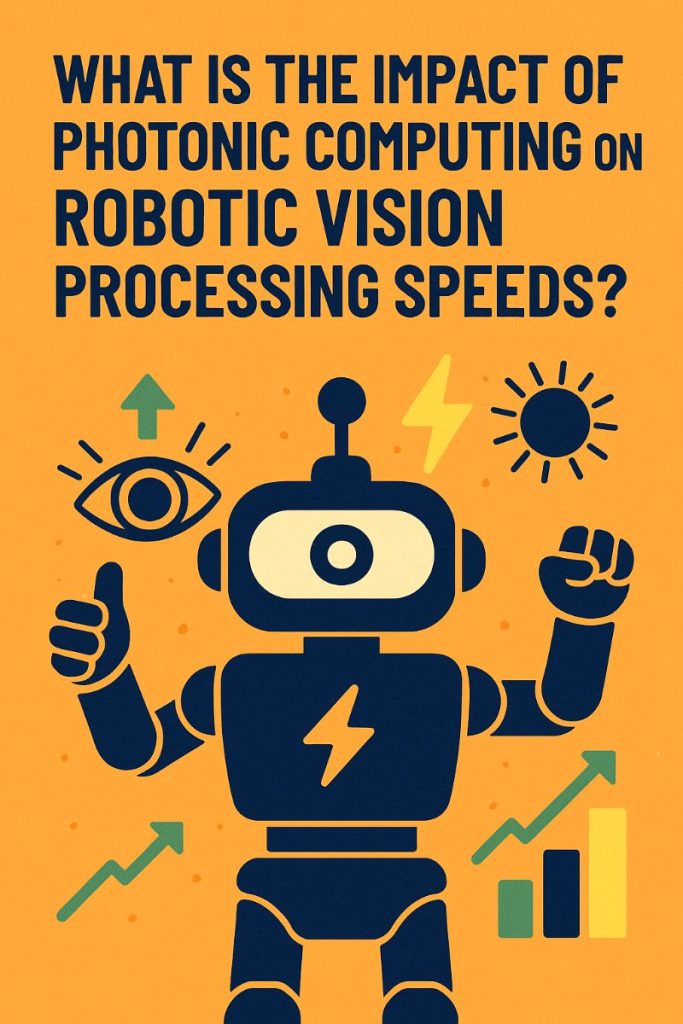Table of Contents
Wait, what is photonic computing?
Why robotic vision even needs speeding up
So…what’s photonic computing got to do with robots seeing faster?
Real-world example time: imagine this robot with LASER EYES
Is this better than traditional computing?
What are the actual speed gains? (Spoiler: They’re wild)
Where are we seeing this stuff now?
Does this mean robots will take over? Chill.
Related tech that makes this cooler (Multimodal AI, 6G, neuromorphic hardware… yep, it’s all connected)
Final thoughts from your friendly AI geek
FAQs (because, yes, you’ve got questions)
1. Wait, what is photonic computing?
Alright. Think of regular computers like a bunch of little electrons running down tiny highways. Cute, but kinda slow. Photonic computing? It’s like—“Nah, I’m using freakin’ light to do my math.” Literal photons zooming through optical circuits. No traffic jams. No overheated chips. Just…light speed.
Crazy, right?
2. Why robotic vision even needs speeding up
Okay, picture a robot in a warehouse. It’s gotta scan packages, avoid bumping into Bob from shipping, and recognize a cat that wandered in (because of course that happens). That means it’s processing a TON of visual data, like, constantly. If it lags? Boom. Collisions. Errors. Annoyed cats.
Faster vision = faster decision-making. Robots that don’t just see, but react in real time.
3. So…what’s photonic computing got to do with robots seeing faster?
Glad you asked, hypothetical friend. Photonic computing handles visual data like a boss. Especially with image recognition, pattern matching, object detection—basically all the stuff that makes a robot go, “Oh hey, that’s a forklift, not a fancy trash can.”
Light-based processing means you get:
Insanely fast image crunching
Way lower latency
Much less power guzzling
Basically, it’s like strapping a rocket engine onto your robot’s eyes.
4. Real-world example time: imagine this robot with LASER EYES
Alright not actual laser eyes, but still. Imagine a robot in surgery (yep, robotic surgery is a thing, and it’s leveling up with 6G networks). It needs to analyze video in real time, react precisely, and not goof up anything at all. Photonic computing makes that real-time processing smoother than a scalpel slice.
Yeah. It’s that serious.
5. Is this better than traditional computing?
Short answer: yep. Longer answer: it depends on the task. For robotic vision? 1000% yes.
Photonic chips can process images with less heat, faster speeds, and parallel processing out the wazoo. That means the robot doesn’t just process one pixel at a time. It’s like processing an entire frame in the blink of an eye. Literally.
6. What are the actual speed gains? (Spoiler: They’re wild)
We’re talking terabits per second of data processed, sometimes even faster. Compared to electronic processors, that’s like comparing a sports car to a turtle on rollerblades. A very tired turtle.
7. Where are we seeing this stuff now?
It’s still early days, but photonic computing is creeping into AI research labs, robotics startups, and yep, even defense projects. You’ll see it hit mainstream when edge devices like drones, autonomous cars, and even farm bots start flexing real-time vision without lag.
And speaking of smart tech in surprising places—ever wonder how AI helps in rural healthcare? Yeah, robots and sensors there could seriously benefit from faster, photonic-powered vision.
8. Does this mean robots will take over? Chill.
Not yet. Let’s not get ahead of ourselves. Just because they can see faster doesn’t mean they suddenly want to overthrow humanity. They still can’t fold laundry right.
9. Related tech that makes this cooler
Photonic computing doesn’t work in a vacuum (pun intended). It’s part of a bigger glow-up happening in robotics:
Multimodal AI – Combining visuals, sounds, sensors—robots that understand like humans. Almost.
Neuromorphic hardware – Chips that mimic human brains. Kinda spooky, kinda awesome.
Quantum computing + swarm robotics – Coordinated robot fleets doing real-time path planning? Yep.
Blockchain for secure robot teamwork – Keeping robot collabs honest.
Self-healing soft bots? You heard that right. Robots that fix themselves. That’s a whole thing now.
10. Final thoughts from your friendly AI geek
So yeah. Photonic computing is a big deal for robotic vision. We’re basically talking about letting robots see the world in high-speed HD while using less power and avoiding brain-melty lag.
It’s still unfolding, but if you’re into robotics, AI, or just love tech that sounds like sci-fi—it’s one to watch. The future’s gonna be fast, bright, and a little weird.
11. FAQs
1. What even is photonic computing?
It’s computing that uses light (photons) instead of electricity (electrons). Way faster, cooler, and less melty.
2. Why does robotic vision need to be so fast?
Because robots need to react in real time—especially in stuff like surgery, driving, or warehouse work. Lag = bad news.
3. Is photonic computing better than traditional CPUs for vision tasks?
For real-time image processing? Heck yes.
4. Is this tech being used right now?
It’s starting to pop up in AI labs and cutting-edge robotics. Still early but promising.
5. Can photonic chips work with other AI tech?
Absolutely. They work best when teamed up with things like neuromorphic hardware or multimodal AI.
6. What about power usage?
Much lower than regular chips. They don’t heat up as much, which is huge for mobile or edge devices.
7. Are they expensive?
Right now? Yeah. But just wait. Once production scales up, prices will chill out.
8. Could this improve stuff like robot surgery?
Totally. Pair it with 6G networks, and you’ve got near-zero-latency surgical bots.
9. Is this related to AI in rural areas?
Funny enough, yes! Faster, low-power robotics help a lot in rural healthcare systems.
10. Will photonic computing replace all other chips?
Not exactly. It’ll work alongside CPUs and GPUs—especially where speed is critical.

